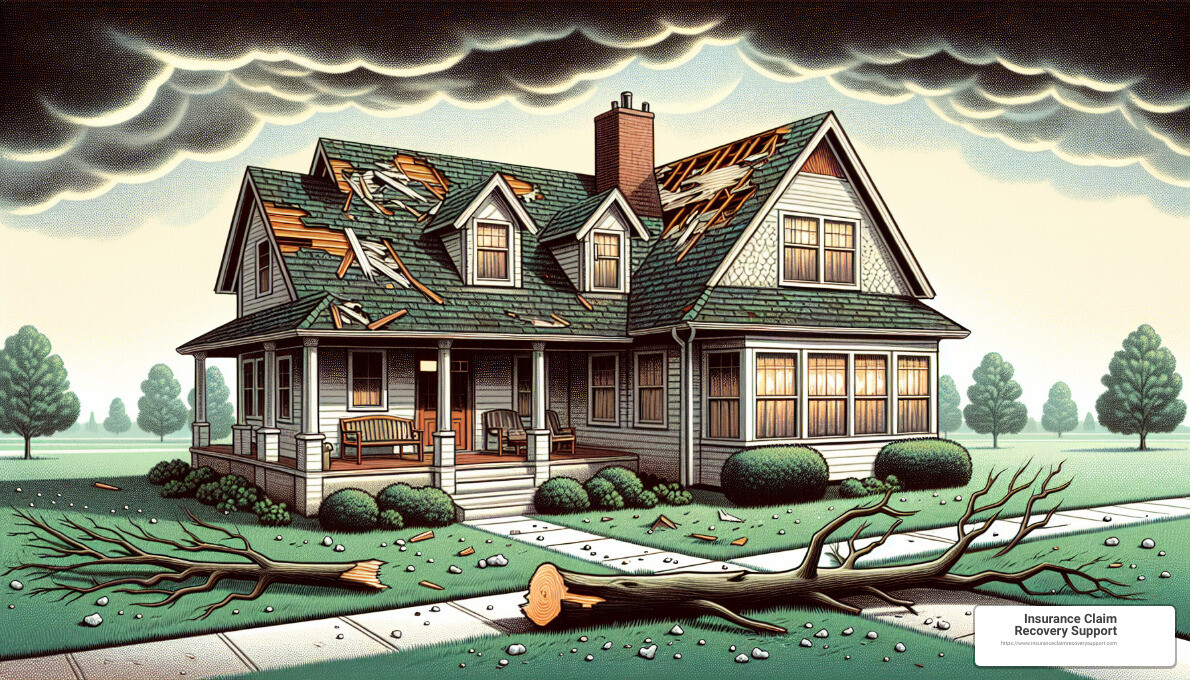Navigating the Hail Storm Insurance Claim Process
If you’ve recently experienced property damage from a hail storm, understanding how to file a hail storm insurance claim can be crucial. Here’s a quick guide:
- Document the Damage: Take clear photos and list all damages.
- Review Your Insurance Policy: Know what your policy covers and any deductibles.
- Contact Your Insurance Company: Report the damage to start the claim process.
- Collect Repair Estimates: Get quotes from several licensed contractors and mitigate damages.
- Meet the Adjuster: Have them assess the damage.
- Finalize the Claim: Review the settlement offered by the insurance and finalize the claim.

Introduction
Hail can cause significant damage to properties, leading to the need for repairs that can be quite costly, especially roof systems. Filing an insurance claim for hail damage is a critical process that enables property owners to recover financially from these losses. Understanding the essentials of Homeowners Insurance and Comprehensive Coverage is the first step towards a successful insurance claim.
Many insurance policies cover hail damage, and knowing how to navigate the claims process effectively can save you not only a great deal of time but also ensure you receive adequate compensation to cover repairs. The goal of insurance is to restore your property to its condition before the damage occurred without undue financial strain on you, the policyholder. Therefore, being thoroughly prepared for the claims process is essential.
Understanding Hail Damage and Insurance Coverage
Hail can be more than just an annoyance; it can cause significant damage to your property. Understanding what your insurance covers and where hail is most common can help you prepare better.
Hailstorm Alley refers to regions in the United States where hailstorms are most frequent. This includes states like Texas, Colorado, Nebraska, and Wyoming. If you live in these areas, it’s crucial to know that hailstorms are not just possible; they’re expected.
Costly Hailstorms have led to substantial financial losses over the years. For instance, in Texas alone, hail damage claims reached a total payout of $510 million in 2022. This high cost shows how destructive and common hail can be in certain areas.
Homeowners Insurance generally covers hail damage. This coverage is part of what’s called “dwelling coverage” and it helps pay to repair or replace the roof, siding, and other parts of your home if damaged by hail. However, the specifics can vary based on your policy details, so it’s always a good idea to review your coverage limits and terms.
Comprehensive Coverage in auto insurance plays a similar role. It covers damage to your car not caused by a collision. This includes hail damage, which can dent your car’s body, break windows, and cause other costly damages.
When you’re reviewing your insurance policies, whether for your home or vehicle, check if hail damage is covered. Knowing this before a storm hits can save you a lot of stress. Also, consider the following:
– Deductibles: This is what you pay out of pocket before insurance kicks in. Make sure you know your deductible amounts.
– Coverage limits: Know the maximum amount your insurance will cover after hail damage.
– Claims process: Familiarize yourself with how to file a claim. You’ll typically need to document the damage and submit a claim form.
Being proactive and understanding your insurance coverage can make a big difference when dealing with the aftermath of a hailstorm. Make sure you’re covered, know what your policy includes, and prepare accordingly if you live in a hail-prone area.
Steps to File a Hail Damage Insurance Claim
When hail strikes, the damage to your property can be significant. Understanding how to navigate the insurance claim process efficiently can help you restore your property quickly and with less stress. Here’s a step-by-step guide to manage your hail storm insurance claim effectively.
Document the Damage
The first step in the claims process is to document all hail damage:
– Take Photographs: Capture clear images of the damage from multiple angles. Include close-ups and wide shots to show the extent of the damage.
– Measure Hail: If it’s safe, measure the hailstones that fell, as this can help establish the storm’s severity.
– Review Policy: Quickly review your insurance policy to understand what is covered and any relevant deductibles.
– Temporary Repairs: If necessary, make temporary repairs to prevent further damage. Keep all receipts, as these costs may be reimbursable.
File a Claim
Once you have documented the damage, it’s time to officially file your claim:
– Insurance Company: Contact your insurance provider immediately. Most companies offer a 24-hour claim filing service.
– Claim-Filing Page: Use the insurer’s website or mobile app to submit your claim. This might be faster than waiting on the phone.
– Representative Contact: Speak directly with a representative to discuss the specifics of your claim and what to expect next.
– Information Submission: Provide all required information including the date of the storm, type of damage, and any emergency repairs made.
Collect Repair Estimates
Before the adjuster visits, get repair estimates:
– Local Contractors: Contact several local contractors to get independent estimates for the repair work.
– Independent Estimates: These help you understand the potential cost and scope of repairs.
– Quotes Comparison: Compare the quotes to ensure they are in line with what is reasonable and customary.
– Contractor Attendance: If possible, have a trusted contractor present during the adjuster’s visit to help ensure the damage assessment is thorough.
Meet With Your Insurance Adjuster
An insurance adjuster will inspect the damage to determine the cost of repairs:
– Adjuster Inspection: Be present during the inspection and show the adjuster all damage documented.
– Damage Assessment: The adjuster will assess the damage and determine the repair costs based on your policy.
– Report Submission: The adjuster will submit a detailed report to the insurance company.
– Settlement Negotiation: If the settlement offered does not cover all repairs, discuss this with the adjuster. You may need to negotiate or provide additional documentation.
Receive a Payout
Understanding the payout process is crucial:
– Advance Payment: Some insurers offer an advance against the total claim amount to start repairs.
– Mortgage Company Coordination: If your home is financed, the payout may need to go through your mortgage lender.
– Direct Contractor Payment: Sometimes, insurers pay contractors directly. Make sure you agree to this arrangement in advance.
– Multiple Checks: For extensive damage, you may receive several payments as repairs progress and further damage is assessed.
Hire a Contractor
Finally, it’s time to repair your property:
– Contractor Selection: Choose a contractor you trust. Verify their licenses and check references.
– Licensed Professionals: Working with licensed professionals ensures that the work meets local building codes and insurance standards.
– Repair Completion: Oversee the repairs to ensure they are done to your satisfaction.
– Proof of Work: Submit all receipts and proof of repairs to your insurer to confirm the work has been completed as agreed.
By following these steps, you can manage your hail damage insurance claim effectively, ensuring that your property is repaired properly and that you receive the compensation you’re entitled to under your policy. Preparation and documentation are key to a smooth claim process.
Identifying and Repairing Hail Damage on Your Roof
Identifying and addressing hail damage on your roof promptly can save you from future headaches and costly repairs. Here’s how you can spot and fix the damage.
Visual Inspection Approaches
Property Survey: Start by walking around your property. Look for visible signs of damage to outdoor items like air conditioning units and patio furniture which can also suggest similar impacts on your roof.
Granule Loss: Check your gutters and downspouts; they often collect the granules that hail knocks off your shingles. A significant accumulation of granules might indicate severe shingle damage.
Roof Edge Inspection: Examine the edges of your roof as they are likely to show damage first. Look for broken or missing shingles and exposed roof layers.
Indicators of Hail Damage
- Dented Gutters and Downspouts: Dents on these can indicate the size and intensity of the hail.
- Bruised Shingles: Feel the shingles for dimples or depressions. When pressed, if they feel soft or spongy, it suggests underlying damage.
- Cracked Tiles: Look for tiles that have splits or sharp lines; these are vulnerable points for water entry.
Types of Hail Damage Repairs
Minor Repairs: Small, isolated areas of damage may only require simple patch jobs or replacing a few shingles.
Extensive Damage: Widespread damage often necessitates substantial repairs or even a full roof replacement, especially if there’s a risk of compromising the roof’s structural integrity.
Replacement Necessity: If damage is severe enough to expose the underlayment or if the roof is nearing the end of its lifespan, replacing the entire roof might be more cost-effective and safer in the long term.
DIY vs. Professional Repairs
While you might consider handling minor repairs yourself, such as replacing a few shingles, be cautious. Roofing work can be dangerous and improperly installed materials can lead to more problems.
For extensive damage, it’s wise to hire professionals. They can ensure that repairs are performed correctly and safely, which also helps in maintaining your roof’s warranty and compliance with building codes.
By following these inspection and repair guidelines, you can ensure your roof is well-maintained and continues to protect your home from the elements. When in doubt, always consult with a professional to avoid any potential risks associated with roof repairs.
Navigating the Insurance Claim Process in Texas
Navigating an insurance claim after hail damage in Texas can feel overwhelming. Here’s a step-by-step guide to make the process smoother and ensure you get the compensation you deserve.
Contact a Local Roofer
First, have a trusted local roofer inspect your damage. They can provide a detailed report on the extent of the damage which is crucial for your insurance claim. Make sure the roofer checks for collateral damage that might not be immediately apparent.
Key steps:
– Schedule an inspection as soon as possible.
– Ensure the roofer checks all aspects of your roof and any related home areas.
– Get a written report detailing the findings.
Contact Your Insurance Company
Next, report the damage to your insurance company. Provide them with the date of the storm and your policy number. This initial contact is crucial in starting your claim process.
Remember to:
– Notify your insurer as soon as you notice the damage.
– Keep your policy number handy.
– Note down and save the details of the person you speak with.
Document the Damage
Take clear photos and videos of all the damage. Document everything, no matter how small. This evidence is vital for your claim and helps ensure you don’t miss out on coverage due to undocumented damage.
Tips for documentation:
– Use timestamps on photos and videos.
– Include a common object in the images for scale.
– Capture multiple angles and aspects of the damage.
Review Your Policy
Understanding your policy’s details, such as deductibles, co-payments, and coverage limits, is crucial. This knowledge will help you understand what financial responsibilities you might face and what damages are covered.
Action points:
– Read your policy thoroughly.
– Highlight or note key coverage and exclusion clauses.
– Prepare questions for your insurer if any part of the policy is unclear.
Meet with an Adjuster
An insurance adjuster will visit your home to assess the damage. This meeting is a critical point in your claim process. Be prepared to show the evidence you’ve collected and discuss the findings of your roofer’s report.
Prepare for the adjuster’s visit by:
– Organizing all your documentation.
– Having your roofer’s report available.
– Preparing a list of damages and affected items.
Negotiate Your Settlement
If the initial settlement offer from the insurance company does not cover all your damages, don’t hesitate to negotiate. You can hire a public adjuster or an attorney specializing in insurance claims to help with this process.
Negotiation tips:
– Review the adjuster’s report and compare it with your documentation and roofer’s report.
– Discuss discrepancies with your public adjuster or attorney.
– Be prepared to present evidence to support your case for a higher settlement.
By following these steps, you can effectively navigate the hail damage insurance claim process in Texas. Proper documentation and understanding your insurance policy are key to a successful claim. If you ever feel overwhelmed, consider seeking professional help from a public adjuster or an attorney to guide you through the process.
Frequently Asked Questions about Hail Damage Claims
Navigating through the complexities of hail damage insurance claims can often lead to many questions. Here are answers to some of the most frequently asked questions by homeowners.
What is the time limit for filing a hail damage insurance claim?
The time limit for filing a hail damage insurance claim can vary depending on your insurance provider and policy. Most insurance companies require claims to be filed within one year of the date of the hailstorm. However, it is crucial to check the specifics of your policy as soon as possible after the event. Delaying can hinder your ability to claim or even prevent you from receiving compensation. Always aim to file promptly to ensure the best outcome.
Does homeowners insurance cover all types of hail damage?
Homeowners insurance typically covers hail damage that impacts the functionality and integrity of your home. This includes damage to the roof, siding, and any other part of the structure compromised by hail. However, some policies may have exclusions or limitations, especially for cosmetic damage — damage that affects the appearance but not the functionality of your home. For example, if hail dents your metal roof but does not cause leaks or structural issues, your policy might not cover the repair costs if they’re considered cosmetic. Always review your policy details or consult with your insurance agent to understand what types of hail damage are covered.
By understanding these key aspects of hail damage claims, you can better prepare and ensure that you receive the compensation you deserve. Thorough documentation and a clear understanding of your insurance policy are critical in navigating this process effectively. If you encounter difficulties or need clarification, don’t hesitate to seek professional advice from a public adjuster or an attorney who specializes in such claims. They can provide valuable assistance and advocate on your behalf to maximize your claim outcome.
Conclusion
When hail storms wreak havoc, the aftermath can often feel overwhelming. But with the right guidance and expertise, navigating the complexities of a hail storm insurance claim can be made significantly easier. At Insurance Claim Recovery Support, we’re more than just your average claim assistance service; we’re your dedicated partner in ensuring you navigate through this process smoothly and effectively.
Our team has a deep understanding of the intricacies of hail damage claims. We know that every little detail counts—from documenting the damage accurately to understanding the specific terms of your insurance policy. Our goal is to ensure that you are not only informed but also well-equipped to handle negotiations with your insurance provider.
We advocate vigorously on your behalf, ensuring that your claim is not undervalued or denied unjustly. Our expertise in dealing with insurance companies allows us to counteract common tactics that might be used to minimize your claim’s payout. We strive to secure a settlement that truly reflects the extent of your damages and the coverage you are entitled to.
Navigating insurance claims can be daunting, and it’s not uncommon to feel lost at times. This is why we emphasize clear communication and thorough preparation. By partnering with us, you gain access to a wealth of knowledge and a robust support system. We guide you through every step, from the initial damage assessment to the final settlement negotiation.
Timely and accurate documentation is your best ally in a hail damage claim. By combining your detailed records with our expertise, we enhance the strength of your claim, ensuring that you receive the maximum possible compensation.
If your property has been affected by a hail storm, don’t navigate the challenging path alone. Let us help you. For more information on how we can assist you with your hail storm roof damage insurance claim, visit our service page at Insurance Claim Recovery Support.
Together, we can turn a stressful situation into a manageable one, ensuring you receive the compensation you need to restore your property and peace of mind.









